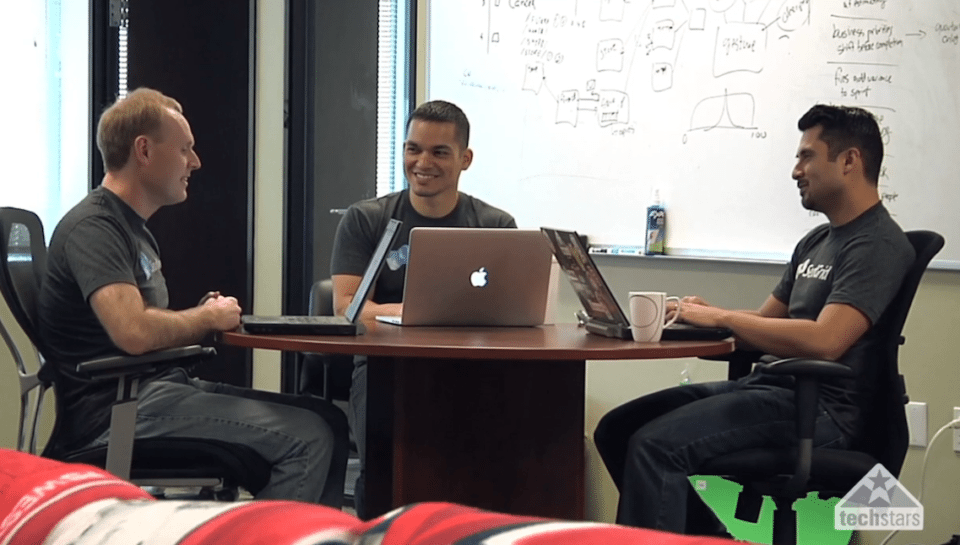SendGrid recently closed a $33 million Series D funding round and now boasts more than 350 employees and a brand new, state-of-the-art office in downtown Denver. However, SendGrid’s humble origins stem from three passionate founders, Isaac Saldana, Tim Jenkins, and Jose Lopez, who set out to solve the problem of email deliverability in 2009.
I had the opportunity to sit down with Isaac Saldana, one of SendGrid’s three co-founders, and the first CEO of the company, to discuss how the business was started. During our in-depth conversation, we discussed Isaac’s past as an entrepreneur, his motivations for starting SendGrid, finding initial product-market fit and the keys to SendGrid’s ultimate success. The story and glimpse into Saldana’s mindset that follows are sure to be invaluable for aspiring entrepreneurs and seasoned professionals alike.
For such a successful founder, Saldana is extraordinarily humble and attributes much of his success to luck.
[blockquote cite="Isaac Saldana" size="small"]"This thing is hard and it’s not going to be given, but consider that a lot of it is luck and just part of the process. So, if you never create a successful startup, it doesn’t mean anything. It just means you didn’t get as lucky as the other person."[/blockquote]
While luck was certainly part of the equation, Saldana's goal was to objectively identify why SendGrid’s founders were able to succeed in spite of the unfavorable odds facing startups. For Saldana, curiosity and persistence were instrumental in identifying a challenging, widespread problem and forming the right team to build a solution.
Consider that SendGrid was Saldana’s fourth startup. To put that into perspective, Saldana had worked on “failed” startups for six years before even beginning on SendGrid, which doesn’t sound lucky in hindsight. While all of those businesses failed from a financial standpoint, they provided invaluable experience that would lead to SendGrid’s success for a number of reasons.
- Saldana developed meaningful working relationships in running startups with SendGrid co-founder Jose Lopez and SendGrid’s 5th employee, Elmer Thomas.
- Saldana, Lopez, and Thomas learned from mistakes they had made in previous businesses.
- Saldana encountered a recurring pain point of email deliverability in all of his previous startups, which would eventually drive him to found SendGrid.
[caption id="attachment_19363" align="alignright" width="685"]

SendGrid co-founders Tim Jenkins, Isaac Saldana and Jose Lopez[/caption]
SendGrid was unique compared with Saldana’s previous startup ideas because, in the case of SendGrid, Saldana was attempting to remedy a problem he was personally experiencing rather than capitalizing on a perceived gap in the market. Each of Saldana’s previous startups struggled with email deliverability. Saldana had discovered that, in an effort to combat massive spam volume, mailbox providers were inadvertently filtering legitimate email as spam, preventing messages from reaching their intended recipients.
Saldana knew he was onto something because of how challenging the problem was to solve. After countless attempts to eliminate the issue, email deliverability kept rearing its ugly head. As a passionate engineer, Saldana was determined to find a solution to his nagging problem and eventually built the foundation for SendGrid.
Upon building a solution to his problem (his MVP or Minimum Viable Product), Saldana visited online forums about cloud hosting to see if others were experiencing the same pain point. As someone who had been passionate about cloud hosting, Saldana regularly participated in these types of forums and figured them to be a promising channel to connect with hosting providers to learn if they could benefit from the solution he had created.
His hypothesis was that if companies are having problems sending from the IP addresses that they would get from hosting companies, the hosting companies should be hearing that from their customers. Saldana went on to say, “I assumed that hosting companies at least had some idea about email [deliverability], said Saldana. "Maybe I wasn’t clear on the hypothesis, but I had some idea, and I was lucky that I guessed right.”
Saldana next sought market feedback to determine if customers would be willing to pay for the solution. Without any funding to commercialize his efforts, he thought of a mutually beneficial solution: give away the product to hosting providers for free to sell to their end customers as a white-labeled offering. In return, the hosting companies would provide the computing resources to run the service. Given the nature of their businesses, the hosting providers had extra capacity to do so, which made the arrangement a win-win. Although Saldana, wasn’t making any money at the time, he was learning about the market, pain point, and solution for free.
After gaining initial traction, Saldana recruited his two co-founders. Because of his past experience, it wasn’t difficult identifying the right people to join him. Saldana had worked with Tim Jenkins while studying at UC Riverside and then in a professional setting when the two worked together at an Aerospace company. Saldana and Jose Lopez had previously worked together on two startups. The challenge was convincing Jenkins and Lopez that a real problem existed, but Saldana’s initial traction demonstrated the significant demand for this type of service.
Saldana points to the addition of his two co-founders as one of the most instrumental events in SendGrid’s history, explaining that he just couldn’t have done it without them. While at Techstars, Jenkins and Lopez wrote most of the code and built much of the product while Saldana was taking care of his responsibilities as CEO, such as fundraising and communicating with customers. Saldana went on to say that he gets too much credit for identifying the problem and says that early employees worked just as hard and as much as he did to grow SendGrid. It seems Saldana has a knack for finding problems, then doing what is necessary to convince incredibly smart people to join him to solve those problems. He has continued doing so as SendGrid has grown and considers each phase of growth to be a new learning experience.
[blockquote cite="Isaac Saldana" position="right" size="small"]“I figured out on the first business that we needed a great team to make technical things happen. On the second business, we got funding, and the combination of a great team and funding made a big difference, but I didn’t think it was enough. You also need great mentors around to help ask the questions you don’t think to ask.”[/blockquote]
 Looking back at his entrepreneurial journey, Saldana says, “I figured out on the first business that we needed a great team to make technical things happen. On the second business, we got funding, and the combination of a great team and funding made a big difference, but I didn’t think it was enough. You also need great mentors around to help ask the questions you don’t think to ask.”
While the potential of receiving funding was attractive, mentorship was the driving factor in applying to Techstars. At the time, email was still relatively new, and Techstars offered great mentors on the topic as well as on the non-technical parts of the business. The mentorship Techstars provided turned out to be invaluable, specifically as it relates to pricing and pitching. From a business standpoint, mentors helped the young company avoid major pricing pitfalls early on.
Saldana offers the following advice to startups:
Looking back at his entrepreneurial journey, Saldana says, “I figured out on the first business that we needed a great team to make technical things happen. On the second business, we got funding, and the combination of a great team and funding made a big difference, but I didn’t think it was enough. You also need great mentors around to help ask the questions you don’t think to ask.”
While the potential of receiving funding was attractive, mentorship was the driving factor in applying to Techstars. At the time, email was still relatively new, and Techstars offered great mentors on the topic as well as on the non-technical parts of the business. The mentorship Techstars provided turned out to be invaluable, specifically as it relates to pricing and pitching. From a business standpoint, mentors helped the young company avoid major pricing pitfalls early on.
Saldana offers the following advice to startups:
- Start small. Focus on one specific area of your product, one persona, or one specific target market.
- Become the best in the world at that one thing. SendGrid’s goal at the time was to become the “best cloud-based email deliverability service for web applications.”
- Once you’re the best in the world, then expand your product/market/focus.
When I asked Saldana what advice he would give to a younger version of himself, he was hesitant to provide any for fear of impeding SendGrid’s eventual success. However, he does have one practical piece of advice for aspiring entrepreneurs: rather than worry about the destination, enjoy the ride. If you spend time working on problems that you are passionate about, you are bound to gain valuable knowledge and form lasting relationships that will position you to take advantage of luck should it eventually strike.
If you're interested in how SendGrid helps startups, read more about our
Accelerate Program.
Photo by Aneta Ivanova on Unsplash



 SendGrid co-founders Tim Jenkins, Isaac Saldana and Jose Lopez[/caption]
SendGrid co-founders Tim Jenkins, Isaac Saldana and Jose Lopez[/caption]
 Looking back at his entrepreneurial journey, Saldana says, “I figured out on the first business that we needed a great team to make technical things happen. On the second business, we got funding, and the combination of a great team and funding made a big difference, but I didn’t think it was enough. You also need great mentors around to help ask the questions you don’t think to ask.”
Looking back at his entrepreneurial journey, Saldana says, “I figured out on the first business that we needed a great team to make technical things happen. On the second business, we got funding, and the combination of a great team and funding made a big difference, but I didn’t think it was enough. You also need great mentors around to help ask the questions you don’t think to ask.”
